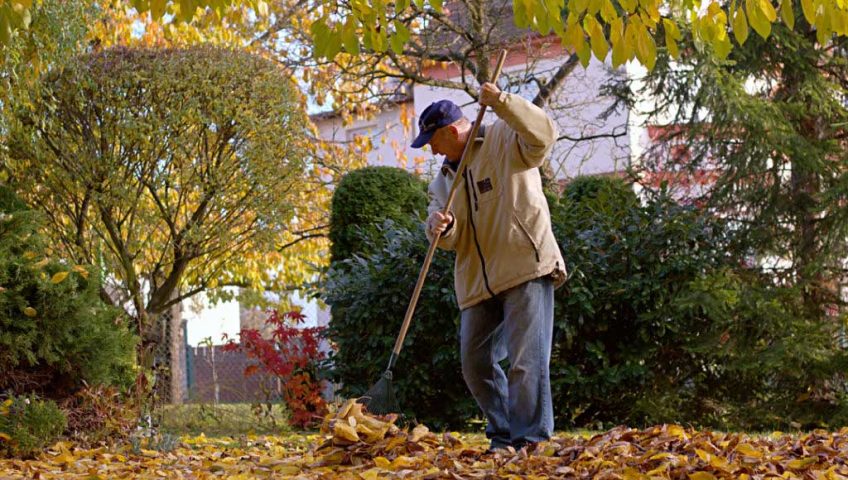A new season has started and autumn is here. The days are shorter and the nights are cooler – and there’s no shortage of fall yard work to do to clean up after summer and get ready for winter. Here are some tasks to undertake in October:
Broadleaf weed control
Next to fertilization, weed control is one of the biggest parts of yard care. In the fall, it’s time to consider measures to control broadleaf weeds – they’re easily identifiable because they don’t look like grass. Tough and aggressive, some examples of broadleaf weeds are dandelions, broadleaf plantain, and stinging nettle.
To treat your lawn you first have to identify broadleaf weeds, and learn their lifecycles. Some broadleaf weeds are perennials – that means they live more than two years and return each year; others are summer annuals, weeds that grow during the summer and die when fall comes. Others are winter annuals, annuals, or biennials.
October is the best time to treat your yard for broadleaf weeds. Select herbicides that are developed for the specific weed(s) you are trying to control. And if you need help, be sure to give us a call: Estimates are free and we can help you identify these invasive plants and design a program to remove them – and in many cases help prevent them from invading again.
Treat your landscape for ticks
If you think the end of summer means the end of tick season, think again: ticks remain active well into the autumn months; in fact, they can remain active until the temperatures dip below 40° F. Spraying for ticks after you’ve cleared the leaves and cut your grass will keep the ticks off your property until the temperatures get much colder.
Urban Tree can tailor a spraying program for you. Spraying is safe for your yard and there is no lasting effect or damage to sprinkler systems since the spray breaks down naturally from sunlight and microbial activity.
Aerate and seed your lawn
A good way to revitalize a lawn that looks a little tired is to aerate and seed in the fall. Lawn thatch build-up can prevent your lawn from getting the air it needs. You may need to undertake core aeration, which uses a machine to remove plugs from your lawn. This relieves compaction and allows water and nutrients to reach the roots of the grass. Following aeration, grass seed can be applied over the aerated soil, for a healthier, more vibrant lawn.
Rake your lawn
Raking is a chore, there’s no doubt. But when you don’t rake, the leaves traps moisture, keeps air and nutrients from getting to your grass, and creates an environment that attracts pests and plant disease. Rake and remove, or finely chop the leaves with your mower (when they’re dry!) so they act as healthy mulch.
Apply lime to your lawn
Slightly acidic soil is good for most grasses, so if you test your soil and it is below 5.5 pH, you might want to apply lime to your lawn during the fall months so your yard has all winter to absorb it. It will take a couple of months for the lime to react with the soil.
You can apply lime with a spreader after you rake and before you plant any seed. Be sure to call us if you need your soil tested, or help applying lime to your lawn.
Plant or transplant trees and shrubs
Fall is a great time to plant trees and shrubs, because planting in the fall allows the roots to grow and be ready and strong by spring. By planting or transplanting several weeks before the first hard frost, the roots of the plantings will have time to get established. Because the weather is cooler, they will need less water, and because the soil remains warm, the roots will develop more quickly. Because most trees and shrubs are going into their dormant state in the fall, they will transfer energy to their roots instead of their above-ground components, such as foliage.
Just be sure not to transplant until after the tree or shrub has stopped blooming.
Look for, and treat pest infestations
Cool season mites – such as spider mites – are active during the fall (and spring) and lay large numbers of eggs. Mites that are present early in the season may not cause much damage, but they can multiply and eventually cause a great deal of damage to trees and plants.
Also inspect your trees for web worm infestations. Web worms are actually moth larvae. You’ll recognize them by the silky nests left in trees and shrubs early in the autumn. These pests can cause defoliation, but because trees have started to shed their leaves by this time of year, web worms may be more of a nuisance than threat. They’re unsightly, however, so you may want to remove them.
Be sure to call Urban Tree Service for help in controlling pests on your trees, shrubs or lawn.
* * *
The end of summer doesn’t mean we stop working! There’s plenty of work that needs to be done in the fall and when winter hits, we’re not only performing tree maintenance, we’re out plowing and shoveling that white stuff off roofs! It’s not too early to plan for winter weather: We’re currently accepting contracts for snow plowing, so give us a call at (603) 332-1246.
